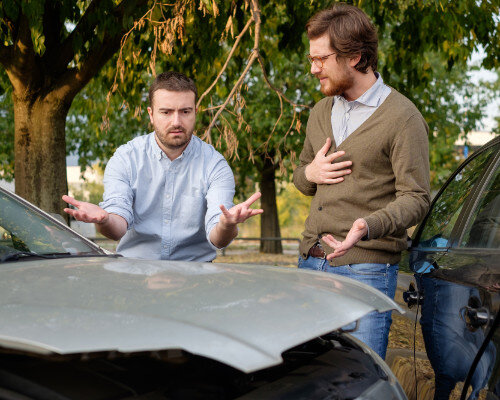
Call Us 24/7 For A Free Legal Consultation







Gross negligence is more aggravated. In Colorado it is defined as the intentional failure to perform a manifest duty in reckless disregard of the consequences as affecting the life or property of another person or party. As citizens, we have a duty to follow the laws and regulations our governments impose on us, and complete lack of consideration for these laws that results in the injury of another person would be considered gross negligence in the eyes of the law. For example, intentionally driving through a red light at an intersection and causing an accident would be gross negligence since you willfully disregarded the traffic laws which resulted in the injury of another person.
These situations have to be dealt with very carefully and negligence needs to be able to be proven in court for it to have an effect on the case, so it is important to understand the differences between ordinary negligence, gross negligence and contributory negligence. If you have any questions after reading this article or are wondering about your case, feel free to contact our Colorado personal injury attorneys for a free consultation and case evaluation.
Negligence is essentially carelessness to your duty as a citizen to act within the limits of the law or reasonable manner with regards to others safety. Negligence is not commonly used in regards to a willful act, but more of a lack of awareness. Most laws are put in place to help keep citizens safe and act as a guide on how everyone can act around other people in a safe manner, so it is your duty as a citizen to know and understand these laws so that you don’t cause accidents and in turn injuries to other people around you. We have all acted negligently at some point or another in our lives, but when our negligent actions cause injury to another person, the person acting negligently may be held responsible for paying for the injuries and damages done to the other party. If the other party has the burden of proof and is able to prove you acted negligently when it goes to court, you may have a large bill to cover due to your lack of care during the time of the incident. Let’s take an in depth look into it all.
“The failure to take proper care in doing something.”
In regards to the law, negligence is “the failure to use reasonable care, resulting in damage or injury to another.” There are four elements to a case of negligence. The existence of a duty of care, the breach of that duty of care, a showing that the breach of that duty was the proximate cause of an injury, and damages that resulted from the breach of that duty. All four elements must be proven to establish negligence under the law.
Negligence can take many forms and happen in all different areas of life, so let’s talk about some common and obvious examples of negligence.
Proving negligence can sometimes be very tricky to do and in some cases it can be very easy but there are four main elements that need to be shown to get a valid injury claim.These are:
In situations where the actions of the person can not be proved easily, lawyers will typically try to recreate the situation and determine if the accident could have been avoided by using reasonable judgement of the situation. If they cannot prove there were negligent actions that took place, then these claims may be thrown out. A great personal injury lawyer will be able to tell from the start if negligence played a role in the accident or not. There are other forms of negligence that can have an effect on your case as well so let’s look at some of the other common types of negligence.
“A lack of care that demonstrates reckless disregard for the safety or lives of others, which is so great it appears to be a conscious violation of other people’s rights to safety. It is more than simple inadvertence, and can affect the amount of damages.”
“A conscious, voluntary act or omission in reckless disregard of a legal duty and of the consequences to another party.”
While there are many different situations that could deem a person’s actions as gross negligence, it needs to show willful disregard for others safety to be able to claim gross negligence and possibly claim punitive damages. Here are some examples:
Proving gross negligence can be hard when there isn’t much evidence to support the claim. However, in some situations, recreating the incident and evaluating how things happened may give either party some data on what was possible and make conclusions based off of that data. And as always, you’ll need to show these four factors to prove negligence: duty, breach, causation and damages. Let’s shed some light on a situation involving gross negligence.
If a driver rear ended someone because they were texting and there were no skid marks, brakes engaged or attempts to avoid the collision, it could be determined to be ordinary negligence. However if there were no skidmarks and the crash was so severe that it could have only happened if the driver was travelling at speeds that were excessively above the speed limit, then this could be considered gross negligence. It’s a grey area that needs to be proven definitively in court and can sometimes drag cases out longer as plaintiffs attempt to prove gross negligence so they can recover punitive damages.
Contributory negligence is typically claimed by the defendant in an injury case, as a means to divert blame from their negligence onto the fact that the plaintiff also acted negligently which played a role in the incident taking place. By proving that the plaintiff’s negligence contributed to the incident, the defendant may be able to get out of paying any damages at all or a reduced amount of the bill since the other party was also partly at fault.
This could be a situation where a person turned right on red in front of another person negligently, but the other person was travelling too fast according to the speed limit. The person who was driving too fast played a contributing role in the accident even though it wouldn’t have happened had the other party not pulled out in front of them. This situation shows that both parties acted in a manner that played a major role in the accident happening.
“Failure of an injured plaintiff to act prudently, considered to be a contributory factor in the injury suffered, and sometimes reducing the amount recovered from the defendant.”
“behaviour that contributes to one’s own injury or loss and fails to meet the standard of prudence that one should observe for one’s own good. Contributory negligence of the plaintiff is frequently pleaded in defense to a charge of negligence.”
Most plaintiffs are just trying to get a settlement to cover the damages and injuries they suffered from the other person’s negligence, but many times the plaintiff is blindsided when the other side claims they also played a part in causing the accident to happen. It is actually quite common but many don’t understand it completely, so here are a few examples to clear up any misconceptions.
If you are going to claim contributory negligence in your personal injury lawsuit, you’ll need to be able to prove those claims which can be difficult in some situations. If there is a clear wrongdoing or breaking of the law by the plaintiff which contributed to the accident it may be easy to prove in court.
However, many times there is not enough satisfactory evidence to prove that the contributing party actually acted negligently. Each case is different in their own way and if evidence to back up the claims isn’t available you may have a hard time getting a judge to acknowledge the claims. At any rate, you’ll need to be able to prove the four main elements of negligence still, which are duty, breach of duty, causation and damages.
If you have been injured due to someone else’s negligent actions, it is extremely important you speak to an experienced personal injury law firm right away so you can get the case settled as soon as possible and ensure you aren’t doing anything that could hurt your chances of a fair settlement. There are many moving pieces to personal injury lawsuits that need to be handled by lawyers who are familiar with the ins and outs of the specific type of accident you were in. Having knowledge of how insurance companies handle things is very helpful as well because most injury cases are going to involve some sort of insurance.
At Rector Stuzynski LLC, our Colorado personal injury lawyers have tons of experience with injury lawsuits of all types and have in-depth knowledge of how insurance companies work so we can get you the best possible settlement for your injuries. We treat every case as if it was our own family that was injured because we believe everyone has the right to a fair and expert defense. If you’ve been injured due to another person or company’s negligence, call us today for a free consultation and evaluation of your case. We are available 24/7 over the phone or feel free to stop by our office in Colorado Springs, CO.
We serve clients injured anywhere throughout the state of Colorado, but we focus on residents of these areas: Colorado Springs, Manitou Springs, Fountain, Briargate, Monument, Black Forest, Pueblo, Canon City, Larkspur, Security-Widefield, Peyton, Castle Rock, Teller County, El Paso County, Elbert County, Park County, Douglas County and beyond.
Consultations are always free and available 24/7 over the phone.